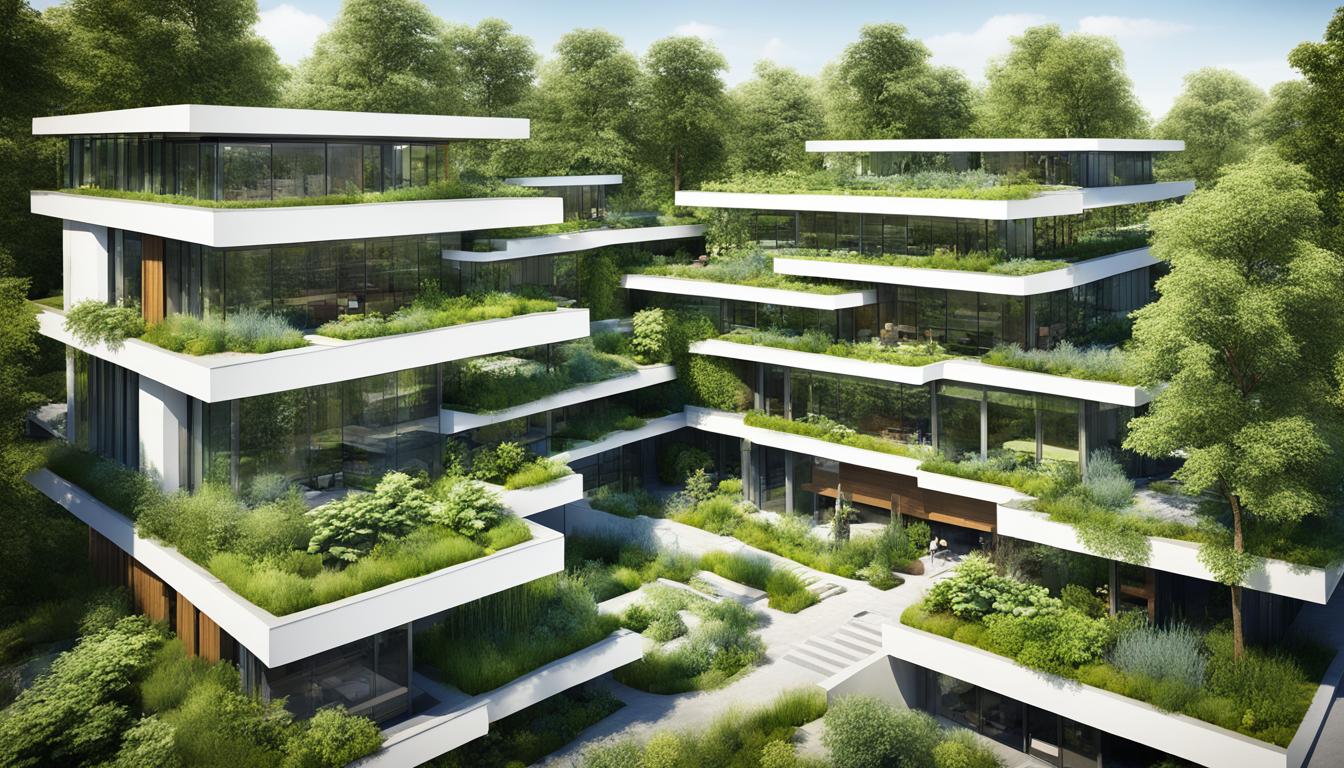
Imagine stepping into a building that feels like a breath of fresh air, a sanctuary amidst the concrete jungle. As you enter, you are greeted by lush green walls, natural light cascading through large windows, and the soothing sound of a gentle waterfall. The air is clean and filled with the scent of fresh flowers. You instantly feel a sense of calm and tranquility wash over you, as if you have been transported to a serene natural oasis.
This is the power of biophilic design, a revolutionary concept that integrates nature into architectural design to enhance biodiversity and promote well-being. Biophilic buildings embrace sustainable practices and seamlessly blend natural elements into their structures, creating an environment that not only enhances the aesthetics of the space but also connects occupants with the benefits of nature.
Whether it’s a vertical garden covering an entire facade or strategically placed water features that mimic natural streams, the integration of natural elements in biophilic buildings brings a multitude of benefits to both individuals and the environment. Research has shown that exposure to nature reduces stress, improves cognitive function, boosts creativity, and promotes overall health and well-being. By immersing ourselves in nature-inspired architecture, we can reconnect with our innate connection to the natural world and reap its rewards.
Key Takeaways:
- Biophilic design integrates nature into architectural design to enhance biodiversity and well-being.
- Nature-inspired elements such as plants, natural light, and water features are seamlessly integrated into biophilic buildings.
- Biophilic buildings promote stress reduction, improved cognitive function, creativity, and overall health and well-being.
- Biophilic design aligns with sustainable practices and contributes to a more environmentally friendly future.
- The future of biophilic design holds promise for healthier, more sustainable, and aesthetically pleasing built environments.
The Importance of Biophilic Design
As the world population continues to urbanize, the importance of biophilic design has become increasingly evident. This innovative approach to architecture integrates nature-inspired elements, such as plants, natural lighting, and green spaces, into building designs. Biophilic design has garnered recognition for its ability to improve well-being and promote a sustainable future.
Research indicates that exposure to nature has a profound impact on human biology. Biophilic buildings have been shown to reduce stress, enhance creativity and clarity of thought, and promote healing. By incorporating biophilic design principles, architects and designers can create spaces that not only enhance the overall quality of life for occupants but also foster a stronger connection with the natural world.
“Biophilic design principles have the potential to transform the way we interact with our built environment. By seamlessly integrating nature into architecture, we can create spaces that support human health and well-being while minimizing the ecological footprint.”
Biophilic design is a response to the growing disconnect between urban environments and the natural world. By infusing nature-inspired architecture with sustainable design practices, biophilic buildings promote environmental responsibility and green building practices. This approach aligns with the vision of creating eco-friendly structures that minimize the impact on the environment.
Overall, the importance of biophilic design lies in its ability to harmonize the built environment with the natural world. By prioritizing the integration of nature-inspired elements, architects can create spaces that not only enhance the well-being of occupants but also contribute to a more sustainable and resilient future.
Biophilic Design Patterns
Biophilic design is based on the understanding that humans have an innate connection with nature. To create a biophilic environment, architects can incorporate various design patterns into buildings. These patterns include:
- Visual Connection with Nature: Integrating views of nature and natural elements, such as landscapes or gardens, into the building design.
- Non-visual Connection with Nature: Incorporating natural sounds, scents, and textures to evoke a sense of nature.
- Non-rhythmic Sensory Stimuli: Utilizing dynamic and varied sensory experiences, such as the sound of flowing water or the sensation of a gentle breeze.
- Thermal and Airflow Variability: Designing spaces that offer temperature and airflow control, mimicking natural conditions.
- Presence of Water: Integrating water features like fountains or ponds, which provide visual and auditory connections to nature.
- Dynamic and Diffuse Light: Maximizing natural light and using light-reflecting surfaces to create a balance of brightness and shadow.
- Connection with Natural Systems: Incorporating elements like green roofs or vertical gardens, blurring the boundary between indoor and outdoor environments.
- Biomorphic Forms and Patterns: Incorporating organic shapes or patterns inspired by nature into architectural elements.
- Material Connection with Nature: Using natural materials, such as wood or stone, to bring the essence of nature into the built environment.
By incorporating these biophilic design patterns, architects can create spaces that emulate the natural environment and promote positive physiological and psychological responses in occupants.
To visualize how these patterns can be integrated into a building, take a look at the image below:
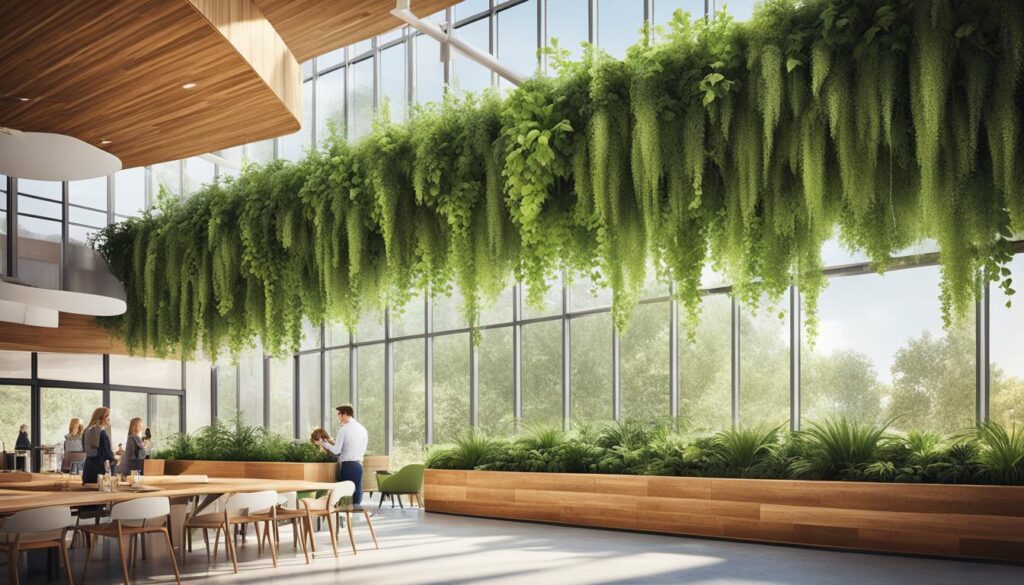
Biophilic Architecture in History
Biophilic architecture, the integration of nature-inspired elements into architectural design, is not a new concept. Throughout history, humans have drawn inspiration from the natural world when creating their living spaces. Ancient structures such as the Egyptian sphinx and Greek temples adorned with acanthus leaves serve as early examples of biophilic architecture.
The incorporation of nature into architectural design goes beyond aesthetics; it provides a sense of refuge and tranquility. By looking back at historical examples, architects can gain inspiration and insights into the proven benefits of biophilic design.
Ancient Biophilic Architecture
Ancient civilizations understood the value of connecting with nature in their architectural creations. The Egyptian sphinx, with its lion body and human head, represents a harmony between the natural world and divine power. The Greeks, known for their reverence of nature, incorporated acanthus leaves, a symbol of growth and life, into the design of their temples.
These architectural marvels demonstrate how early civilizations recognized the importance of integrating nature into their built environment. They sought to create spaces that not only reflected the beauty of the natural world but also provided a harmonious and calming atmosphere for their inhabitants.
“Biophilic architecture is a testament to how humans have always sought connections with nature in every aspect of their lives.”
Proven Benefits of Biophilic Design
Biophilic architecture is not just about aesthetics; it has tangible benefits for its occupants. Research has shown that exposure to nature in the built environment can improve physical and mental well-being. Incorporating natural elements such as plants, water features, and abundant natural light can reduce stress, enhance cognitive function, and promote a sense of well-being.
By studying the historical use of biophilic design principles, architects can gain valuable insights into creating spaces that foster positive physiological and psychological responses in individuals. This connection with nature can have a transformative impact on urban spaces and the well-being of the people who inhabit them.
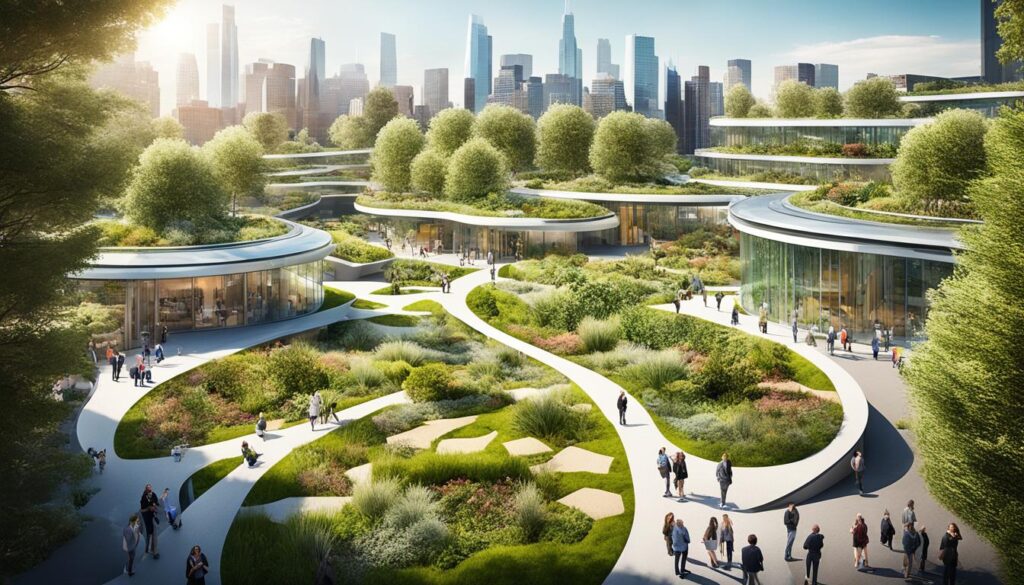
The Influence of Biophilic Architecture Today
The principles of biophilic architecture continue to shape contemporary design practices. Architects and designers today seek to create spaces that reconnect individuals with nature, even in the heart of urban environments. This concept, known as urban biophilia, acknowledges the human need for nature-inspired surroundings and aims to integrate green spaces, natural materials, and sustainable design practices into urban landscapes.
By embracing biophilic design, architects and urban planners can create cities that prioritize the well-being of their inhabitants while contributing to the overall sustainability of the built environment.
Ancient Biophilic Architecture Examples
| Structure | Location | Description |
|---|---|---|
| Egyptian Sphinx | Egypt | Ancient monument featuring a lion body and human head, symbolizing the connection between the natural and divine realms. |
| Greek Temples | Greece | Temple structures adorned with acanthus leaves, reflecting the Greeks’ deep appreciation for nature and its role in their daily lives. |
The table above showcases a few examples of biophilic architecture from ancient civilizations, highlighting their utilization of nature-inspired elements in their design.
Biophilic Design and Sustainability
When it comes to creating sustainable and eco-friendly buildings, biophilic design plays a crucial role. Biophilic buildings are meticulously designed with a focus on sustainable practices, aiming to minimize their impact on the environment. By incorporating nature-inspired elements and green building practices, architects can create spaces that not only enhance the well-being of occupants but also contribute to a more sustainable and resilient future.
In the construction of biophilic buildings, eco-friendly construction materials are key. These materials are sourced responsibly, often using renewable resources and minimizing carbon emissions. By opting for sustainable materials, such as recycled or locally sourced materials, architects can reduce the environmental footprint of the building process.
In addition to using eco-friendly materials, biophilic buildings prioritize the incorporation of renewable energy sources. This can be achieved through the installation of solar panels, wind turbines, or geothermal systems. By harnessing natural sources of energy, biophilic buildings reduce reliance on non-renewable resources and contribute to a more sustainable energy mix.
Moreover, green building practices are integral to the design of biophilic buildings. These practices include water conservation measures, such as rainwater harvesting and efficient irrigation systems, as well as the implementation of energy-efficient technologies, such as LED lighting and smart HVAC systems. By adopting these practices, biophilic buildings minimize energy and water consumption, reducing their environmental impact.
Biophilic design goes beyond incorporating nature-inspired elements; it also considers the health and well-being of occupants. Natural lighting, ventilation, and the integration of indoor plants positively impact the physical and mental health of building users. Research has shown that exposure to natural light enhances productivity, reduces stress levels, and improves overall well-being. Furthermore, plants improve air quality by filtering pollutants and increasing humidity.
In summary, biophilic design and sustainable practices go hand in hand. By using eco-friendly construction materials, incorporating renewable energy sources, and implementing green building practices, biophilic buildings offer a sustainable and resilient solution for the built environment. These buildings not only minimize their environmental impact but also prioritize the health and well-being of their occupants. Biophilic design, with its focus on sustainability, creates spaces that harmonize with nature, promoting a more sustainable future for generations to come.
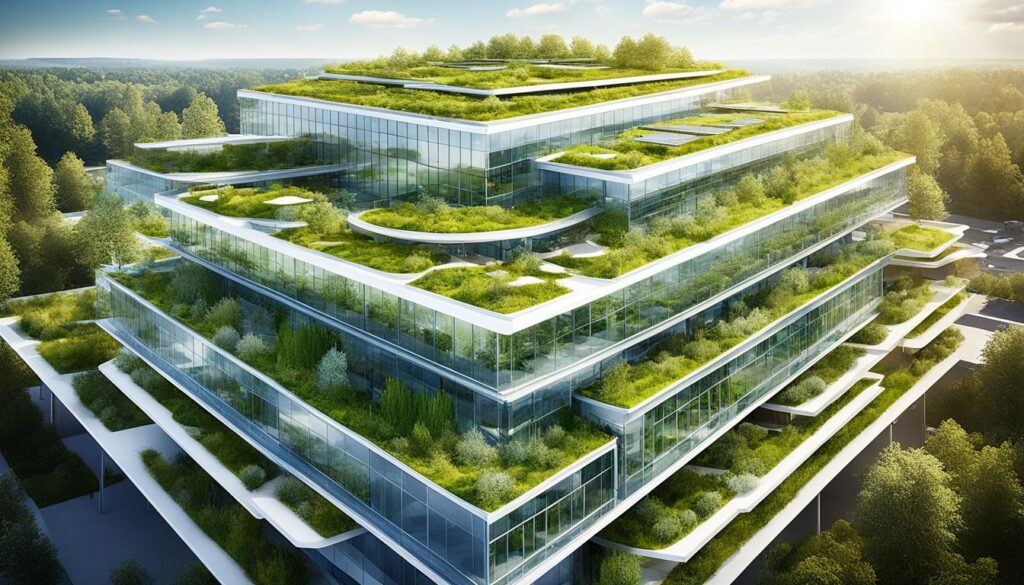
Examples of Biophilic Buildings
There are numerous examples of biophilic buildings around the world that showcase the integration of nature and architecture. One example is the Fifth + Tillery office building in Austin, which features a courtyard resembling the native ravine microhabitats of Central Texas and includes an onsite reclaimed water system. Another example is The Tower at PNC Plaza in Pittsburgh, which uses the concept of biomimicry to optimize solar collection and natural ventilation. These examples demonstrate the wide range of possibilities in biophilic building design and the positive impact they can have on both individuals and the environment.
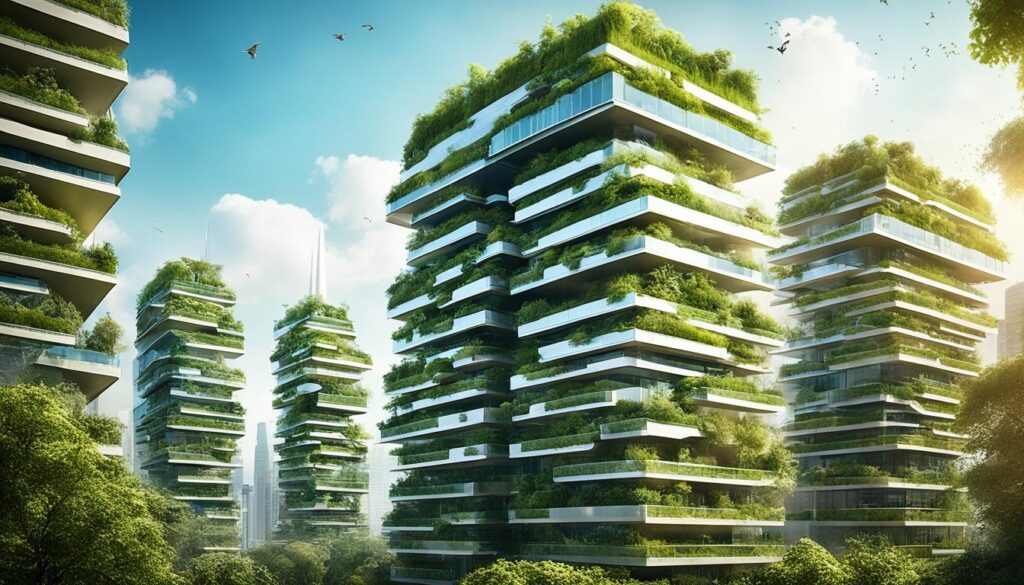
Biophilic buildings have gained popularity in recent years, with architects and designers incorporating nature-inspired elements into their projects in innovative ways. These buildings not only provide aesthetically pleasing spaces but also contribute to sustainability and the well-being of occupants. Let’s explore two compelling examples of biophilic buildings that exemplify the integration of nature and architecture.
Fifth + Tillery Office Building, Austin
The Fifth + Tillery office building in Austin, Texas, is a prime example of a biophilic building that seamlessly blends nature with architecture. The building features a meticulously designed courtyard that emulates the native ravine microhabitats found in Central Texas. This unique outdoor space incorporates various elements such as native plants, trees, and natural materials to create a serene and inviting environment.
Moreover, the Fifth + Tillery building goes beyond its visual appeal by implementing sustainable design strategies. It boasts an onsite reclaimed water system, reducing water waste and promoting efficient resource management. By integrating these biophilic and sustainable design elements, the Fifth + Tillery building offers occupants a truly harmonious and eco-friendly workspace.
The Tower at PNC Plaza, Pittsburgh
The Tower at PNC Plaza in Pittsburgh, Pennsylvania, stands as a remarkable example of biophilic design and sustainable architecture. This innovative skyscraper utilizes the concept of biomimicry, drawing inspiration from nature’s efficiency and adaptability. The building’s design incorporates numerous features that optimize solar collection and natural ventilation, reducing energy consumption and promoting a healthier indoor environment.
One of the key biophilic design elements of The Tower at PNC Plaza is its innovative double-skin facade. The outer layer of the building mimics the pattern of a leaf, providing shade and minimizing heat gain while still allowing natural light to filter through. This design not only reduces the building’s reliance on artificial lighting and air conditioning but also creates a soothing and visually engaging atmosphere for occupants.
By embracing biophilic design principles, The Tower at PNC Plaza not only showcases architectural excellence but also sets new benchmarks for sustainable and eco-friendly building practices.
Biophilic Design and Industrial Design
In addition to its application in architecture, biophilic design principles can also be integrated into industrial design, expanding its reach beyond the confines of buildings. By incorporating biophilic elements and attributes into the design of industrial goods, designers can create products that establish a deeper connection with nature and enhance the well-being of users. This approach to industrial design not only contributes to sustainable practices but also presents opportunities for innovative and creative solutions.
A key aspect of biophilic industrial design is the use of natural materials, which not only adds a touch of authenticity but also elevates the aesthetic appeal of the product. For example, furniture made from sustainably sourced wood or textiles crafted from organic fibres can create a sense of harmony with the environment. Such designs not only bring the beauty of the natural world into our spaces but also support eco-friendly practices by prioritising sustainable materials.
Biomorphic forms are another element of biophilic industrial design that emulates nature’s patterns and shapes. Taking inspiration from the curves and organic lines found in the natural world, these forms can create a calming and visually pleasing presence. By incorporating biomorphic elements into product design, such as chairs with flowing contours or electronic devices with soft, rounded edges, designers can evoke a greater sense of tranquility and well-being.
| Benefits of Biophilic Industrial Design | Examples |
|---|---|
| Enhanced well-being and user satisfaction | A set of ergonomic office furniture inspired by the natural movement and diversity of trees. |
| Increased product appeal and marketability | Biodegradable packaging made from sustainable materials for a range of personal care products. |
| Promotion of sustainable practices and materials | A line of kitchen appliances made from recycled stainless steel and bamboo components. |
| Improved brand perception and eco-conscious image | An electric vehicle with an interior design that incorporates natural textiles and finishes. |
Bio-collaboration is also gaining momentum in the field of biophilic industrial design. This approach involves collaborating with experts from various scientific disciplines to develop products that are not only aesthetically pleasing but also highly functional and sustainable. By combining principles from biology, engineering, and design, innovative solutions can be found that mimic the efficiency and resilience of natural systems.
Furthermore, bio-inspired design entails studying and replicating nature’s strategies, forms, and processes to create smart and efficient products. For instance, taking cues from the wings of birds to enhance aerodynamics or imitating a plant’s ability to self-clean to develop dirt-resistant surfaces. By harnessing nature’s billions of years of evolution, designers can develop products that are not only exceptional in performance but also aligned with sustainable practices.
Biophilic design principles applied in industrial design can transform everyday products into harmonious and nature-inspired objects that bring joy and well-being to users. By integrating elements such as natural materials, biomorphic forms, and bio-collaboration, designers have the opportunity to create innovative solutions that not only enhance the user experience but also contribute to a more sustainable and eco-friendly future.
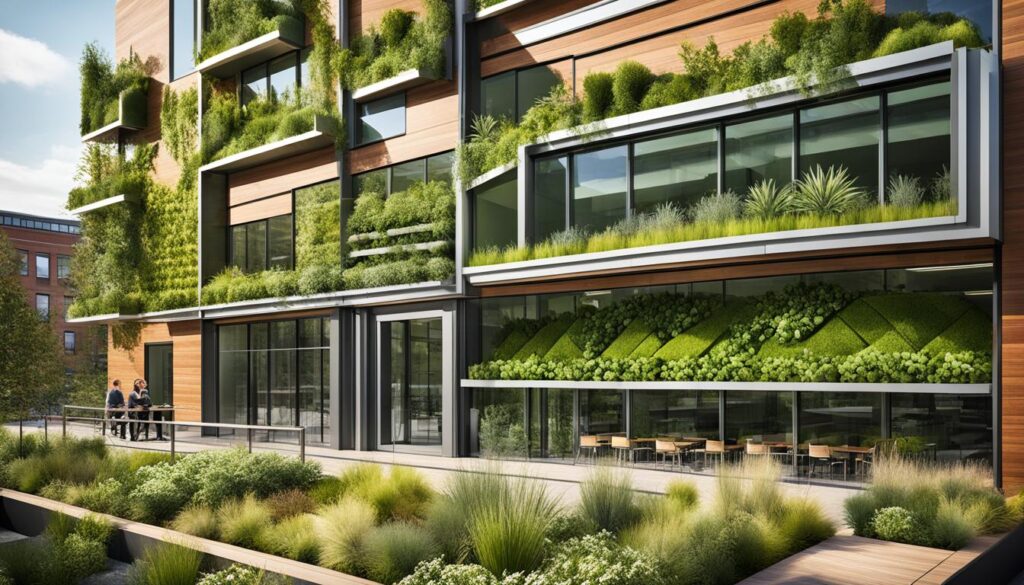
The Future of Biophilic Design
The future of biophilic design is bright and promising. This innovative approach to architecture and design continues to gain recognition for its positive impact on well-being and its contribution to sustainable practices. As new research emerges and technology advances, there will be even greater opportunities to explore and implement biophilic design principles across various sectors.
Biophilic design is set to become more widespread and integrated into mainstream design practices, leading to healthier, more sustainable, and aesthetically pleasing built environments. By incorporating biophilic elements, architects and designers can create spaces that prioritize the well-being of individuals and foster a stronger connection with the natural world.
With the increasing emphasis on sustainable design, biophilic buildings are poised to play a significant role in creating a more eco-friendly future. By integrating nature-inspired elements and sustainable practices, these buildings minimize their impact on the environment while enhancing the overall quality of life for occupants.
The possibilities for biophilic design are expanding as technology advances. From the use of advanced materials to harnessing the power of smart technology, there are exciting opportunities to enhance the integration of nature into architecture.
“Biophilic design has the potential to revolutionize the way we approach architecture and design. By prioritizing the connection with nature, we can create spaces that not only look beautiful but also enhance the well-being of individuals and contribute to a more sustainable future.”
The role of technology
Advancements in technology are paving the way for new possibilities in biophilic design. From energy-efficient systems to smart controls, technology can help optimize the integration of natural elements into the built environment. For example, automated shading systems can adjust according to the position of the sun, allowing for optimal natural lighting while reducing energy consumption.
Integrating sensors into buildings can help monitor and manage environmental conditions, ensuring that occupants are always connected to nature. This includes controlling temperature, humidity, and air quality to create a comfortable and healthy indoor environment.
Biophilic design in urban areas
In urban areas, where green spaces are limited, biophilic design offers a solution to reconnect people with nature. By introducing rooftop gardens, vertical green walls, and indoor green spaces, biophilic design can transform concrete jungles into vibrant and sustainable urban environments.
Biophilic design principles can be integrated into all aspects of urban planning and architecture, from public parks to office buildings and residential complexes. Creating a strong urban biophilia helps improve the well-being and quality of life for city dwellers, while also positively impacting the local ecosystem.
Continued research and collaboration
The future of biophilic design relies on continued research and collaboration among architects, designers, researchers, and policymakers. By sharing knowledge, studying the impact of biophilic design, and seeking innovative approaches, we can further refine the principles and practices of biophilia.
| Advantages of Biophilic Design in the Future | Challenges to Overcome |
|---|---|
| Improved well-being and productivity for occupants | Limited awareness and understanding of biophilic design principles |
| Enhanced sustainability and reduced environmental impact | High initial costs of implementing biophilic design |
| Increased connection with nature in urban areas | Integration of biophilic design into existing structures |
| Opportunities for innovative technologies and materials | Lack of standardized guidelines for biophilic design |
As biophilic design continues to evolve and gain popularity, it has the potential to reshape the way we approach architecture and design. By embracing the principles of biophilia and integrating nature into the built environment, we can create spaces that are not only visually appealing but also promote well-being, sustainability, and a deeper connection with the natural world.
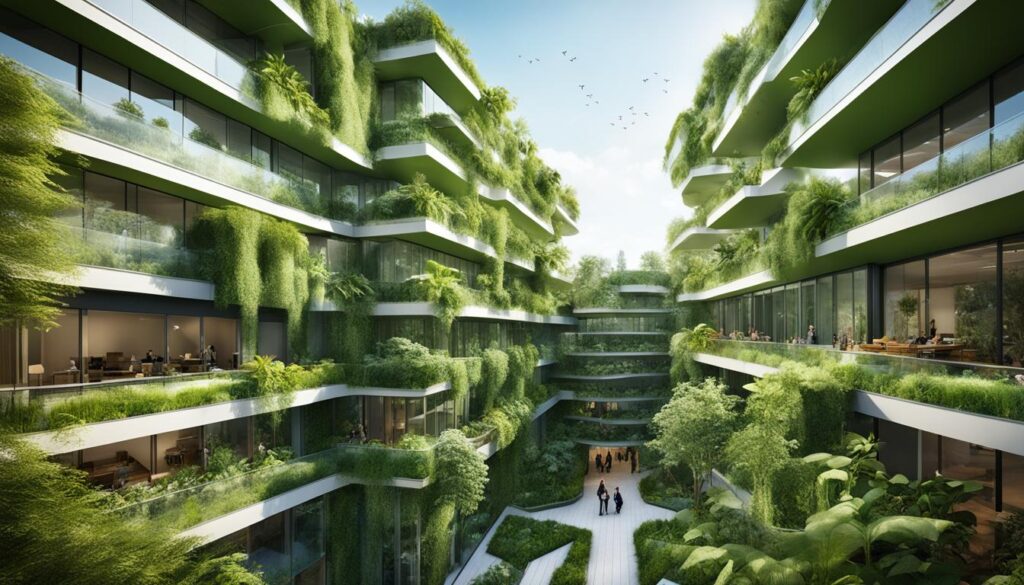
Conclusion
Biophilic buildings are a testament to the power of integrating nature into architectural design. By incorporating elements such as plants, natural lighting, and water features, architects and designers can create spaces that not only look beautiful but also enhance the overall well-being of occupants. The benefits of biophilic design extend beyond aesthetics; they contribute to sustainability by using eco-friendly practices and materials, minimizing the impact on the environment.
These nature-inspired spaces offer a holistic approach to design, enhancing biodiversity and promoting a stronger connection with the natural world. Research has shown that biophilic buildings contribute to a range of positive effects on individuals, including reduced stress, improved cognitive function, and increased creativity. By prioritizing the well-being of occupants and incorporating sustainable design principles, biophilic buildings create a healthier and more harmonious living and working environment.
The future of biophilic design is bright. As the world embraces the importance of sustainability and the benefits of incorporating nature into the built environment, biophilic design will become increasingly prevalent. With an increasing focus on creating spaces that prioritize the well-being of individuals and promote a stronger connection with the natural world, the integration of biophilic design principles will lead to a future where buildings not only coexist with nature but actively contribute to its preservation.
FAQ
What is biophilic design?
Biophilic design is a concept that involves integrating elements of nature into architectural design to enhance biodiversity and promote well-being.
What are the benefits of biophilic buildings?
Biophilic buildings have been proven to reduce stress, improve cognitive function, and contribute to overall health and well-being.
How does biophilic design contribute to sustainability?
Biophilic buildings are designed with a focus on sustainable practices and the integration of natural elements, such as plants, green spaces, natural lighting, and water features.
What are some examples of biophilic buildings?
Examples of biophilic buildings include the Fifth + Tillery office building in Austin, which features a courtyard resembling native ravine microhabitats, and The Tower at PNC Plaza in Pittsburgh, which uses biomimicry to optimize solar collection and natural ventilation.
How can biophilic design be integrated into industrial design?
Biophilic design principles can be incorporated into industrial design by using natural materials, incorporating biomorphic forms, and creating products that promote a stronger connection with nature and enhance user well-being.
What is the future of biophilic design?
The future of biophilic design is promising, with an increasing focus on creating spaces that prioritize well-being and promote a stronger connection with the natural world.
